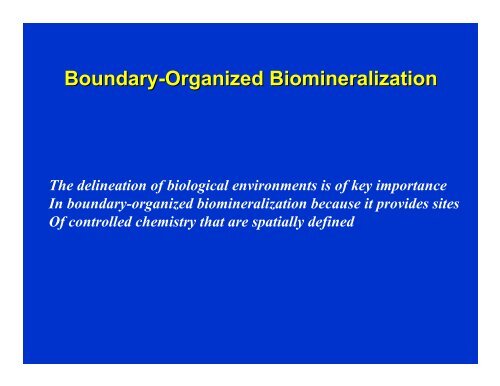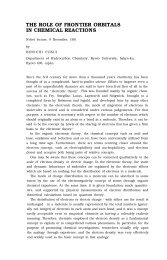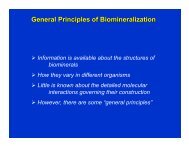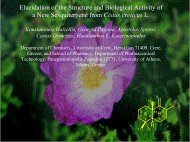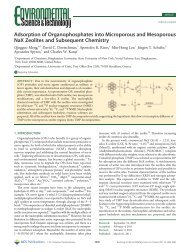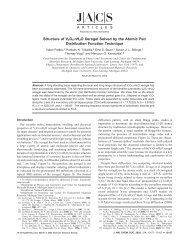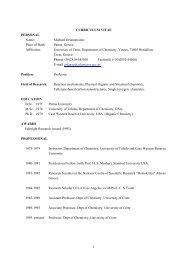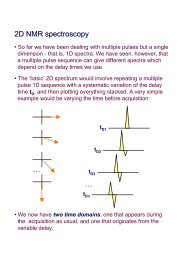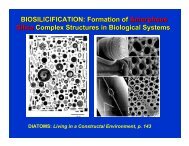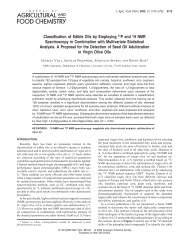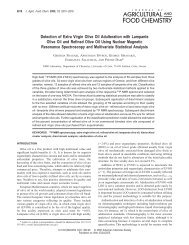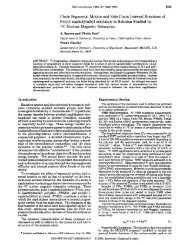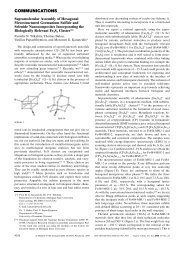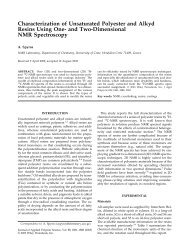Lecture-7 (boundary-organized biomineralization)
Lecture-7 (boundary-organized biomineralization)
Lecture-7 (boundary-organized biomineralization)
You also want an ePaper? Increase the reach of your titles
YUMPU automatically turns print PDFs into web optimized ePapers that Google loves.
Boundary-Organized<br />
Biomineralization<br />
The delineation of biological environments is of key importance<br />
In <strong>boundary</strong>-<strong>organized</strong> <strong>biomineralization</strong> because it provides sites<br />
Of controlled chemistry that are spatially defined
Outline<br />
‣Spatial Boundaries<br />
‣ Supersaturation control within spatial boundaries<br />
‣ Ion transport<br />
‣ Ion fluxes in calcification
Phospholipid Vesicles<br />
‣ Vesicles are fluid-filled compartments enclosed by a<br />
continuous bilayer<br />
‣ They form spontaneously under specific conditions<br />
‣Their spontaneous self-assembly arises from balancing<br />
hydrophilic and hydrophobic interactions<br />
‣ They frequently adopt spherical structure (minimum total<br />
surface energy for a given volume)
Phospholipid Vesicles
Phospholipid Vesicles<br />
‣ Phospholipids are key membrane constituents of<br />
biological vesicles<br />
‣ They readily form self-sealing biomolecular sheets<br />
‣ Packing of the molecules in the bilayer is quite loose<br />
‣ High degree of lateral fluidity for moving of molecules<br />
into or outside the vesicle<br />
‣ Proteins are also present in the vesicle membrane that<br />
may span the entire 4 to 5 nm thickness of the bilayer
Phospholipid Bilayer Membrane
Golgi Complex and Surrounding Vesicles
Inorganic Mineralization in Vesicles:<br />
Magnetotactic Bacteria
Formation of bacterial magnetite crystals<br />
‣ Uptake of Fe(III) ions from the environment<br />
‣Reduction of Fe(III) to Fe(II) ions during transport across<br />
the cell membrane<br />
‣ Transport of Fe(II) ions to and across the vesicle<br />
membrane (the magnetosome membrane)<br />
‣ Preciitation of amorphous hydrated Fe(III) oxide within<br />
the vesicle<br />
‣ Transformation of the amorphous phase to magnetite by<br />
surface reactions involving mixed-valence intermediates
Formation of bacterial magnetite crystals
Protein Vesicles: Ferritin
Protein Vesicles: Ferritin
Protein Vesicles: Ferritin
Protein Vesicles: Ferritin
Macromolecular Frameworks<br />
‣ Cells are often tens of micrometers in size (very large)<br />
‣ Disadvantage: mineral growth can get out of control<br />
‣ Organisms often partition the mineralization space into<br />
smaller enclosures<br />
‣ Semi-permeable organic matrices with open framework<br />
structures<br />
‣ Mineral growth becomes contained at a more local level<br />
where it can be spatially <strong>organized</strong>
Growth of calcite in Avial Shell
Growth of Goethite (α-FeOOH(<br />
FeOOH) ) on Limpet Teeth<br />
Chitin is the template for goethite growth
Aragonitic Nacreous Layer of Seashells
Aragonitic Nacreous Layer in Gastropods<br />
Aragonitic Nacreous Layer in Seashells


